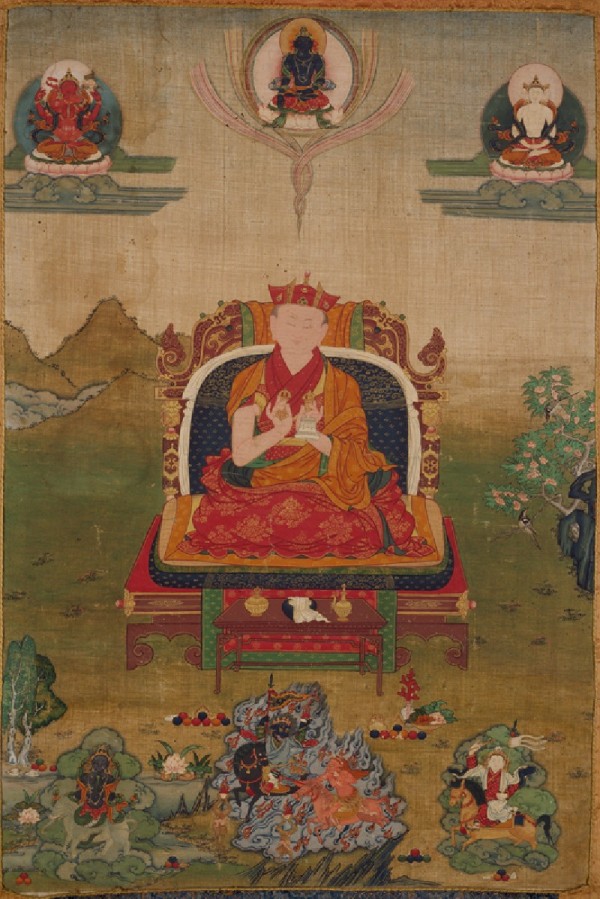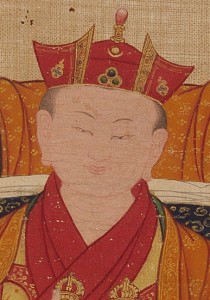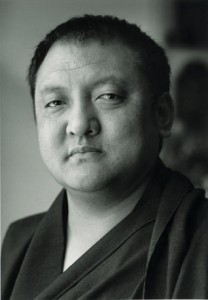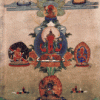This beautiful thangka painting of the 10th Shamarpa Mipham Chodrup Gyamtso (1742-1792), in the Karma Gardri style of Eastern Tibet, was painted in the middle of the 18th Century, and is currently on display at the Ashmolean Museum in Oxford.
The 10th Shamarpa was a significant figure in the history of the Karma Kagyu tradition. He was recognized and enthroned by the 13th Karmapa Düdul Dorje and by the 8th Situ Rinpoche, from both of whom he had received all the Instructions of the Lineage. He traveled and taught extensively, especially in Kham and within the areas of Derge and Nangshen.
The 10th Shamarpa was a brother to the 6th Panchen Lama Palden Yeshe (1738-1780), a highly ranked Gelugpa Lama. The 10th Shamarpa had a very poor relationship with the Gelugpa government of Tibet that was based in Lhasa and directly ruled by the Chinese Emperor Qianlong (1711-1799). Tsomonling Ngawang Tsultrim, the imperial Chinese representative in Lhasa at that time, was especially opposed to him for a number of reasons. First of all, he belonged to the Karma Kagyu school and claimed that that the Kagyus were the former rulers of Tibet. Second, he was on friendly terms with the British government in India, a state of affairs that had come about because his mother was a princess of Ladakh. Both of these facts made the Emperor’s government very suspicious. Fearing censure or punishment from the governments of both Tibet and China, the 10th Shamarpa fled to Nepal. He lived there comfortably until, in 1788, a war broke out between Tibet and Nepal over the minting and circulation of counterfeit coins. The 10th Shamarpa was used by the government of Nepal as a mediator in the peace talks with Tibet, and as a result the government of Tibet informed the Emperor Qianlong that the Shamarpa had taken the side of the Nepalese in the conflict. The Shamarpa’s Red Crown was seized and in collusion with the army, all his monasteries were forcibly appropriated and integrated into the Gelugpa School.
The Shamarpa spent his remaining years in Nepal and in spite of the circumstances, the true spirit of generosity and patience of a bodhisattva shone through in its fullest magnificence. The 10th Shamarpa diligently performed buddha activities and saw to the spiritual needs of people wherever they arose.
Upon the death of the 10th Shamarpa in 1792, the Gelugpa Tibetan government passed a law banning the institution of the Shamarpa, forbidding any future recognition and enthronement. From 1792 until 1963, no Shamarpa reincarnation was enthroned, although the 11th, 12th, and 13th Shamarpas were secretly recognized during that time by the Karmapas. In 1963, the 14th Dalai Lama and the 16th Gyalwa Karmapa formally restored the institution of the Shamarpas, enthroning the current 14th Shamarpa Mipham Chokyi Lodro.
The title Shamarpa, means ‘Holder of the Red Hat’. In this painting Shamarpa holds the ritual dorje and bell and wears the Red Crown. The crown of the Shamarpas is unique and patterned on the black crown of the Karmapas. In paintings and sculptures of the Shamarpas, the ornament on the front is either a three- or five-jewel emblem, a double dorje, or a simple diamond emblem. According to the Himalayan Art Resource, observing 20 images, both painting and sculpture, 3 have a simple diamond emblem, 6 have a three-jewel emblem, 10 have a five jewel emblem, and one has a double vajra emblem.
We encourage everyone, especially those of you who have met with the current Shamar Rinpoche, to to visit the Ashmolean Museum in Oxford to see the beautiful thangka first hand. It can be located on the first floor in Room 32 (India from 600) – one can’t help but be struck by the facial likeness between this painting of the 10th Shamarpa and the current 14th Shamarpa.
At the top left of the image is the yidam Almighty Ocean (Skt. Jinasagara, Tib. Gyalwa Gyamsto), a red form of Loving Eyes (Skt. Avalokiteshvara, Tib. Chenresig) in union. At the base of the painting are three Protective forms. The central form is the lion-faced Pure Land Protector (Tib. Shing Kyong Kunga Zhonnu). He considered to be the protector of Dewachen (Skt. Sukhavati), the pure realm of the Buddha of Limitless Light (Skt. Amitabha, Tib. Opame), of whom the Shamarpas are considered to be emanations.
Other posts which may be of interest :
Tags: Karma Gardri, Karma Kagyu history, Oxford







 Follow
Follow